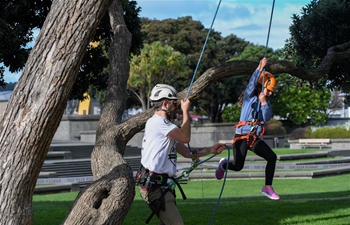BEIJING, June 8 (Xinhua) -- An intangible cultural heritage fair, which showcases 40 items on the List of United Nations Educational, Scientific and Cultural Organization (UNESCO) World Intangible Cultural Heritage, started in the southern Chinese city of Guangzhou from Friday.
The fair includes exhibitions, shows, lectures and forums to present the vivid practice of intangible cultural heritage protection and development in China.
It is among China's continuous efforts to build and enhance intangible cultural heritage protection.
COLORFUL ACTIVITIES
Since 2006, China has celebrated cultural heritage day on the second Saturday of June. In 2017, it was renamed Cultural and Natural Heritage Day.
More than 3,200 activities have been scheduled across China to celebrate this year's cultural and natural heritage day, which falls on June 8.
Aiming to raise the public's cultural confidence and awareness, the "open course on intangible cultural heritage," an educational television show that invites experts to tell stories about the inheritance of intangible cultural heritage, was broadcast on Friday evening.
An exhibition on Guqin, the Chinese zither, a Kunqu Opera performance and a photo exhibition of intangible cultural heritage are also scheduled.
A concert featuring traditional Chinese music and poems was held in the National Library Thursday to commemorate the Dragon Boat Festival. Artists performed classical poems with dance and played traditional instruments including Pipa.
The National Library will hold another five activities in June and July to showcase intangible cultural heritage and study its protection.
EXCLUSIVE BUT NOT "LOST" TECHNIQUES
As of 2018, Henan Province in central China owned 127 national-level intangible cultural heritage inheritors and 832 provincial-level ones, covering all fields of lives.
In order not to let these exclusive techniques become lost, the province has undertaken a series of measures to preserve and carry forward the heritage.
Some inheritors of wood paintings, paper cuts and porcelain have been sent to institutions of high education to learn about changes in social needs. Their products have absorbed modern fashions and characteristics.
China has spent 300 million yuan (43.5 million U.S. dollars) protecting the intangible cultural heritage of Tibet Autonomous Region over the past 13 years.
According to the regional people's art museum, from 2006 to 2018, the central government spent 195 million yuan, while the regional government spent over 80 million yuan in the protection of intangible cultural heritage.
Tibetans in poverty-stricken areas now have a chance to make their way out through traditional craftsmanship, since 10 workshops were set up this March to promote employment and shake off poverty as local residents learn to make intangible cultural heritage handicrafts, such as Tibetan incense, Buddhist prayer flags and Pusum hand-engraving.
NATIONWIDE NETWORK
China has set up a nationwide intangible cultural heritage protection network comprising 2,467 institutions and 17,308 personnel as of the end of 2018, according to a government report.
These institutions sponsored about 65,500 related performances and over 16,800 folk culture activities in 2018, attracting 98 million people to watch, said the report from the Ministry of Culture and Tourism.
In 2018, a total of 1,082 individuals were newly recognized as artists with the responsibility of carrying forward the country's intangible cultural heritage, figures from the report show.
The figure brought the total number of national-level inheritors of intangible cultural heritage in China to 3,068.
China has 1,372 representative intangible cultural heritage programs under state protection. And it has 40 programs on the UNESCO World Intangible Cultural Heritage List.
The government earmarked 201 million yuan last year from the central budget to build 26 national facilities for the protection and utilization of intangible cultural heritage.
China has, in recent years, continued to promote regulations, classified protection, capacity building and international exchanges concerning intangible cultural heritage, said Li Jinzao, vice minister of culture and tourism.
"The environment to inherit and develop intangible cultural heritage has significantly improved, and colorful intangible cultural heritages are blossoming in the garden of Chinese culture," Li added.

















